Updated on January 17, 2025
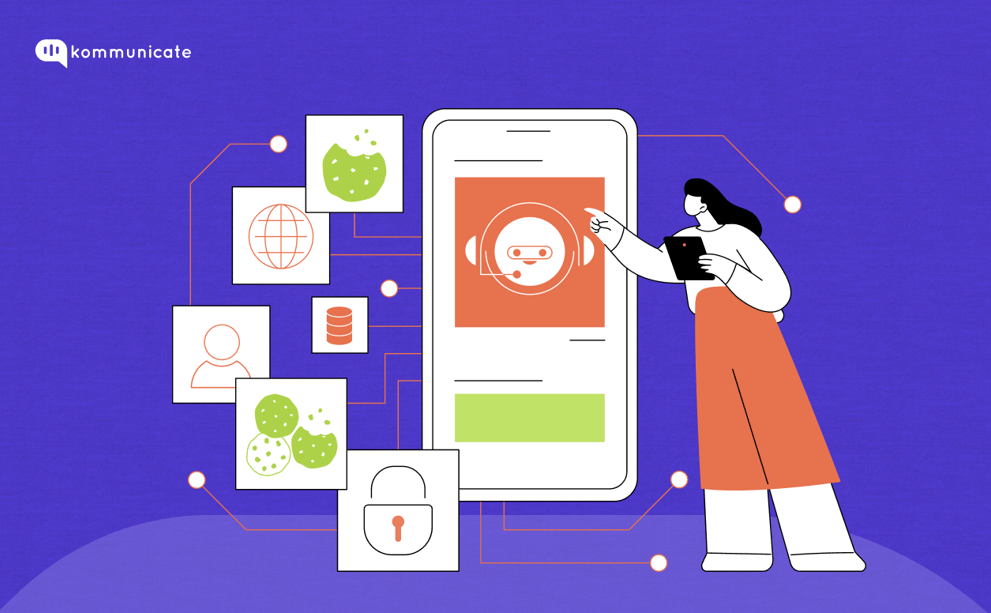
We have all encountered this scenario. You are browsing through your favorite news website or travel blog and suddenly a screen pops up that asks you explicit permission. The wordings go something like this:
We use third-party cookies on our website for advertising purposes: Allow or Deny?
But what does this mean actually? What are internet cookies? And why are they in the news all of a sudden? We answer all these questions and much more in this blog post.
In 2023 alone, for instance, the average cost for a data breach was around 4.45 million dollars, a 15% increase over the past 3 years, according to this IBM report. The European Union (EU) is strict with customer data too. In the year 2023, the Irish Data Protection Commission (DPC) fined a whopping 1.2 billion euros against Meta Platforms Ireland, ltd. part of the Facebook group.
So data protection laws are here to stay, and chatbots, with cookies that enable data collection, will constantly evolve.
With this context, here is a list of what we will cover in this article:
- What are cookies?
- Types of cookies used in chatbots
- How chatbots collect user data through cookies
- Types of personal data chatbots may collect through cookies
- Difference between essential and non-essential cookies
- GDPR and CCPA for chatbots
- Why are GDPR and CCPA essential for chatbots?
- Key requirements of GDPR and CCPA for cookie compliance
- Benefits of cookie compliance in chatbots
- Challenges of cookie compliance with chatbots
- Frequently Asked Questions (FAQs)
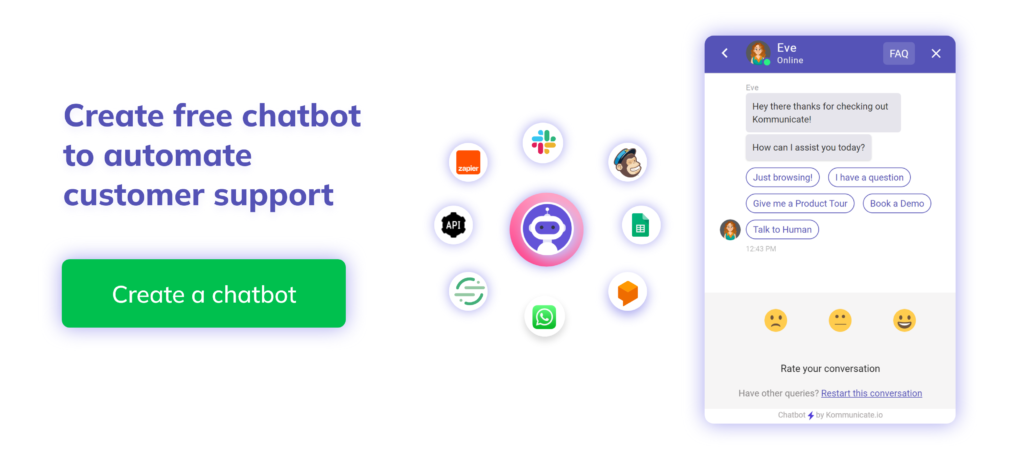
Do you want to learn more about chatbots and how to use compliances to improve customer support of your business? Check out these articles:
- How to Create a Chatbot in 10 Minutes
- An Essential Guide to HIPAA Compliance in Healthcare Chatbots
- 5 Proven Ways How Chatbots Can Help Enterprise Businesses Scale
Let us explore each of these questions in detail.
What are cookies?
Cookies are bits of code that store tiny amounts of information about a user in the form of a text file, acting like a website’s memory. This is so that when the user visits a website and has shown interest in a particular item, the website can serve similar items to the visitor.
Cookies help in personalization and user convenience. They are used by the website to identify your computer as you use a network. The server creates the data stored in a cookie as soon as you connect.
A network engineer by the name of Lou Montulli invented the HTTP cookie in the late 90s, and since then, cookies have become indispensable to any website.
Chatbots, which are used by users to interact with a website, also employ cookies
sometimes. Chatbot cookies are similar to website cookies, with a few minor differences.
| Sl No. | Feature | Regular Cookies | Chatbot cookies |
| 1 | Scope | All the websites you visit | Only the chatbots you are interacting with |
| 2 | Purpose | Personalization and website functionality. | To improve the performance of the chatbot. |
| 3 | Privacy | Can raise privacy concerns, since they track user behavior across multiple websites. | Less of a concern since they are only used within a chatbot. |
| 4 | Lifespan | Session or persistent. | Generally session cookies. |
So we now know that chatbot cookies are a bit different from regular HTTP Cookies. So, what are the different types of chatbot cookies? Let’s find out.
Types of Chatbot Cookies
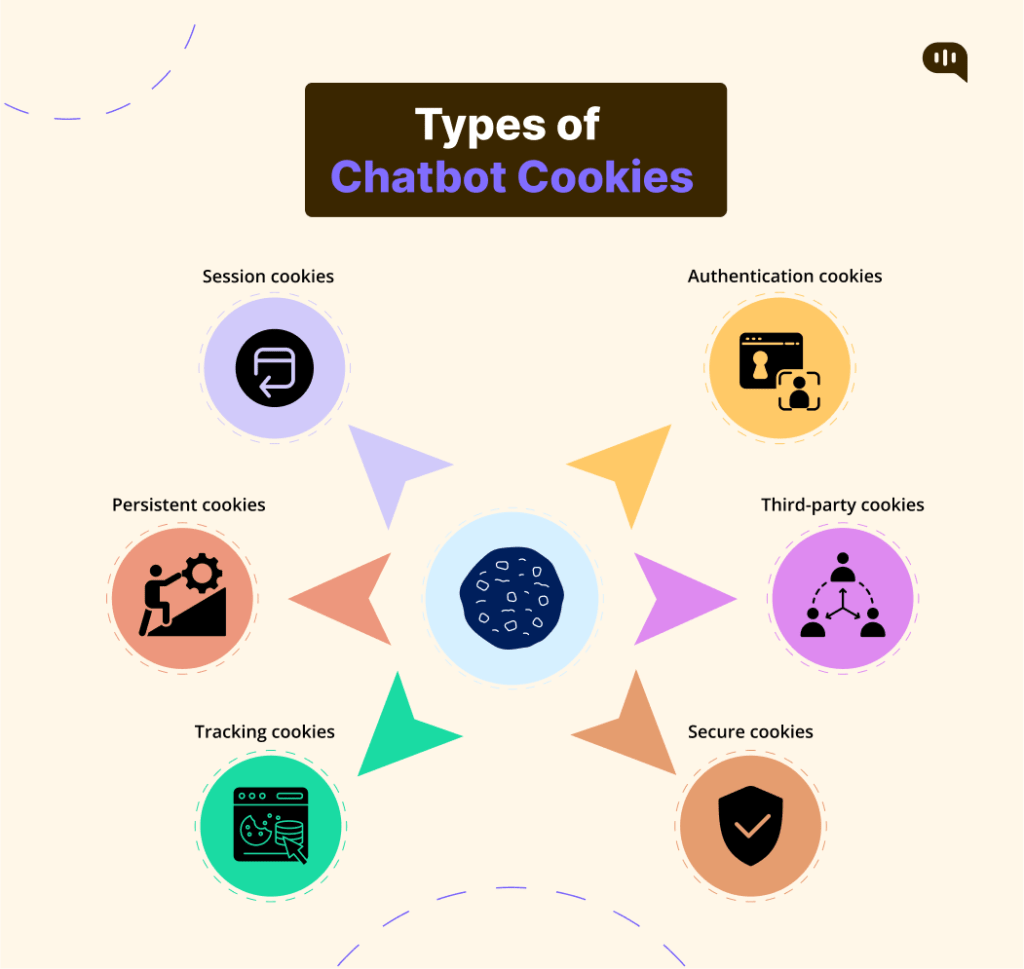
Just like a regular cookie, chatbots also can store and retrieve data as and when they feel appropriate, once the user has entered the information. There are six different types of cookies that chatbots use to identify users, which include:
- Session cookies: These are temporary cookies, snippets of information stored during a user’s conversation session with the chatbot. They are needed to maintain continuity in a conversation, and they store this information about users within a single session. This will ensure that as long as the session is active, the chatbot remembers the user’s responses. What happens when the session ends? Well, these cookies are generally deleted, and hence the name, “session cookies.”
- Authentication cookies: User authentication is a key function of chatbots, especially when they are the gatekeepers to personalized content or information. When users need to provide credentials or login information, that is when authentication cookies are employed. By storing the authentication information and only allowing authorized users to access content, authentication cookies thus play an important role in verifying a user’s identity.
- Persistent cookies: These are advanced versions of session cookies that store user information for a longer period. They can store various types of information including login details, favorite features, past purchase history, etc. They help identify return customers, and remembering customer information over multiple sessions helps them provide a more personalized customer experience.
- Third-party cookies: When the chatbot accepts cookies from an external domain to serve you personalized content, that is the use of a third-party cookie. Integrations, advertisements, or analytics are some of the use cases of third-party cookies. A classic example of the use of a third-party cookie would be you booking a flight from New York to Chicago and then the chatbot on the airline website telling you about the snowy weather conditions in Chicago.
- Tracking cookies: Ever had a chatbot that talks to you seamlessly, understanding your preferences beforehand and taking you through a conversation path that you had initiated before? This is done with the help of tracking cookies, which monitor and record user behavior. The main objective of tracking cookies is to help businesses understand how users are navigating through their conversations.
- Secure cookies: Think of secure chatbot cookies as encrypted data snippets that traverse between a user’s browser and a chatbot server over HTTPS. This makes sure that the data exchange is secure and confidential. Secure cookies make sure that there is no session hijacking, unauthorized access or tampering with data. They thus enhance user privacy and lead the way to a more trustworthy experience.
Now that we have seen the different types of chatbot cookies, it is time to see how these cookies function.
How do chatbot cookies collect user data?
The process of chatbots collecting user data through cookies is not that complex. These cookies can be Session cookies or Persistent cookies, as explained earlier. As you chat, the chatbot “plants” cookies, or small files containing data, on your device.
The information that is collected may be your name, email address, IP, and location to personalize your chatbot experience. Your conversation history may also be stored, so that the chatbots get an idea of what you are going to ask, and the choices you make. The chatbot will also try to understand your purchase intent with every link you follow, every product you view, or every button you click.
The chatbot will then use this data to personalize your experience, show you targeted ads, and improve its overall performance.
While this is just a brief overview of how chatbots collect user data and how they use it, we are not going into the technical details. Know this: You must ensure that the chatbots deployed on your website only collect information after getting consent from visitors.
Let us now see the type of personal information that chatbots can collect through cookies.
Types of personal data that chatbots may collect through cookies
Various types of personal data can be collected by chatbots through cookies. Some of the major types include:
- User preferences: User preferences are stored by persistent cookies, and they may include language preferences and theme settings, among other customization choices.
- Session information: Stored by session cookies, this may include data related to the current conversation, including dialogue history and user inputs.
- Device information: The data collected by cookies may also be specific to the type of device that the customer uses, including its make, OS, browser type, etc.
- User identification: Chatbots can use cookies to store identifiers or tokens that help identify a user during a particular conversation.
- User behavior: This may include the paths that the user takes, interactions with specific features, and FAQs.
- Authentication data: This type of information allows cookies to store information related to user logins and secure sessions, allowing users to remain authenticated.
While the types of personal data that chatbots may collect have been briefly touched upon, it is also important to note the differences between essential and non-essential cookies for chatbots. Let us explore this bit in more detail.
Differences between Essential and Non-Essential Cookies for Chatbots
Here are the major differences between essential and non-essential cookies for chatbots.
| Sl No. | Feature | Essential Cookies | Non-essential cookies |
| 1 | User preferences | May store basic user preferences for a session | Stores user preferences over multiple sessions. |
| 2. | User consent | Essential cookies are often exempt from consent requirements. | Due to their non-essential nature, requires user consent. |
| 3 | Duration of storage | Usually stored for a small duration / single session | Stored for a longer duration / spanning multiple sessions. |
| 4 | Impact on Functionality | Crucial for functioning and chatbots may not function at all properly without them. This can lead to disruption in basic tasks like remembering past questions. | Even in the absence of non-essential cookies, the chatbot will continue to function normally. Only small effects on features like personalization. |
| 5 | Regulations | In most cases, it is exempt from regulations like GDPR and CCPA. | It is subject to strict regulations due to their potential for profiling users. |
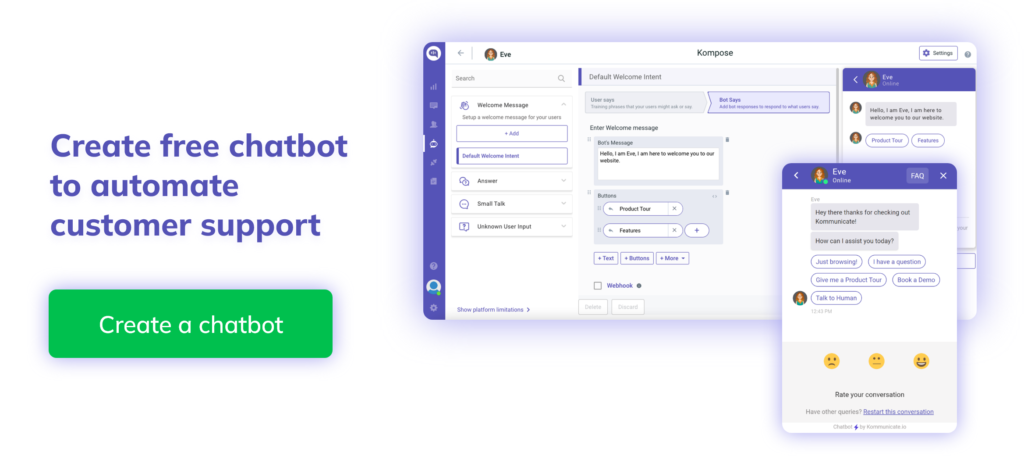
Now that we have seen the differences between essential and non-essential cookies, let us explore the various regulations that they may be subject to since they deal with sensitive customer information.
GDPR and CCPA for Chatbots
What is GDPR?
GDPR stands for General Data Protection Regulation and is a set of comprehensive data protection laws in the European Union (EU) designed to protect personal data. Companies that have European customers must comply with the GDPR to avoid legal consequences.
In the context of chatbots, there are several strict requirements that GDPR has laid down on how chatbots can collect, store, and process personal data. Users, for instance, must know why their details are being collected and how long it will be stored by the chatbot. GDPR compliance is important for fostering trust and respecting user privacy.
What is CCPA?
The California Consumer Privacy Act (CCPA) is similar to the GDPR, except that it is for the residents of California, USA. CCPA is also a data protection law, and, in the context of chatbots, it establishes a set of regulations for businesses that collect, process or share the personal information of California residents. Residents of California have the right to access, delete, or request information held by chatbots.
Chatbots complying with CCPA ensures that the business is transparent, respects user privacy, and fosters a culture of trust.
Why are GDPR and CCPA essential for chatbots?
We know by now that both GDPR and CCPA are strict data protection laws, and they are essential to protect user privacy. Some of the other reasons why these laws were laid down include
- User consent: Both GDPR and CCPA make it crystal clear that user consent must be taken well in advance before collecting or processing personal data through cookies. Users must know what data is being collected and the reason behind it, along with the option to opt out of this data collection.
- User rights: With GDPR and CCPA, users get specific rights concerning their data, which include the right to access, control, or delete their information.
- Security: Both CCPA and GDPR ensure that there are rigid security measures in place to protect personal data that is collected via cookies from unauthorized access. Similarly, a HIPAA compliant chatbot ensures that sensitive medical information is handled with the highest level of security, safeguarding it from breaches and unauthorized access.
- Accountability: Organizations are held accountable for protecting user data by ensuring compliance with GDPR and CCPA regulations. They thus show that they are committed to respecting user privacy and fostering a culture of trust.
Non-compliance with GDPR and CCPA has severe financial consequences and can cause a severe loss to companies. This can also extend to reputational damage, along with loss of access to key markets such as the EU or California.
Key requirements of GDPR and CCPA for cookie compliance
Here are some of the key requirements of the data protection laws, that will help you save a tonne of resources while building your chatbot.
- Transparency: You should be transparent about your cookie policy, displaying it in a cookie banner that informs users about cookie usage. You should also inform users if there are any updates in your cookie policy.
- Consent: One key thing to remember about consent is that users must explicitly opt into cookie tracking, not opt-out by default. They must clearly understand the kind of data that is being collected and where they are used. Within the same chatbot interface, users should also be ready to withdraw their consent.
- Data protection: As a rule of thumb, collect and process only the least amount of data required for the chatbot to function normally. Implement robust security measures to make sure that there is no unauthorized access to data, and also prevent loss or breach of data.
- Geography: Make sure that your chatbot confirms all the requirements of GDPR and CCPA, in case you are targeting customers from regions such as the EU or California.
- Third-party cookies: In case your chatbot uses third-party cookies, make sure that the third-party cookie provider complies with data protection laws as well.
We have seen the key requirements you need to take into account in case you want your chatbot to be GDPR/ CCPA compliant. Now, let us look at a few of the benefits of cookie compliance in these chatbots.
Benefits of cookie compliance in chatbots
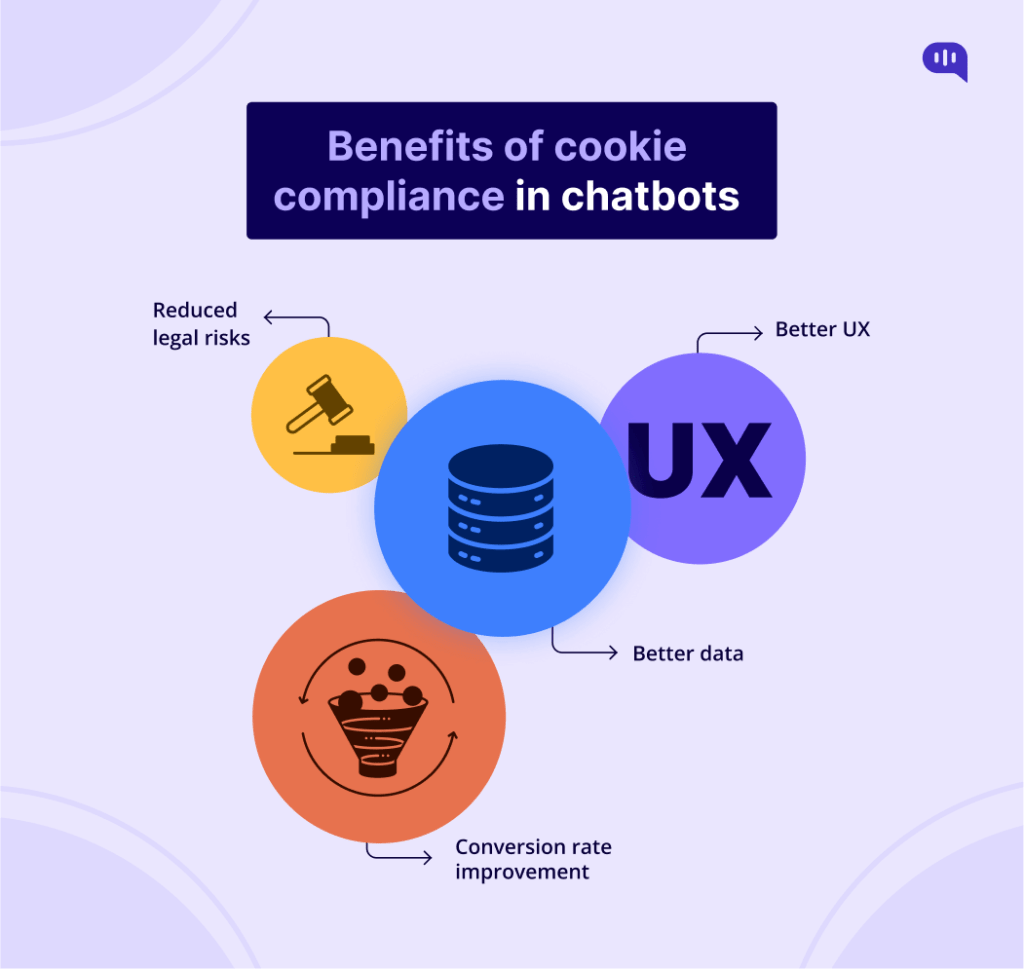
Making your chatbot compliant with GDPR / CCPA not only fosters a sense of trust among your customers. Here are some of the other key benefits:
- Reduced legal risks: With regulatory non-compliance, there is always the risk of a hefty legal fine, something which many small businesses cannot bear. Being GDPR/CCPA compliant is the first step in mitigating this risk.
- Better UX: When you give customers granular control over their data, you are personalizing the experience they have with your chatbot, which will lead to more positive interactions.
- Better data: When you minimize the amount of data that you collect, you are paving the way for more relevant, higher-quality data that your chatbot can learn from.
- Conversion rate improvement: When customers trust you as a brand and see that you are taking all the steps to protect their data, they will naturally convey. Being compliant with data protection laws can thus lead to more sales and better business.
Challenges of cookie compliance with chatbots
Here are some of the challenges that users may face while ensuring cookie compliance with Chatbots.
- User awareness and consent: Getting explicit consent from users while making them fully aware of all the nitty-gritty details can be challenging, especially when done within the framework of a chatbot. Users may not know all the details behind how their data will be used, and obtaining informed consent requires crystal clear communication.
- Data storage concerns: Chatbot interactions are dynamic, and this adds a level of complexity when they have to stick to compliance. One must ensure that users have complete control over their data and can easily manage cookie settings within the conversational flow. This is done through thoughtful design and seamless integration.
- Balancing personalization and user privacy: Protecting user privacy while providing a personalized experience through data that is collected through chatbot cookies – this is a tightrope walk that requires a tough balancing act.
- Minimizing data retention and security: For compliance, one must minimize the amount of data collected and limit its retention period. But this also comes with a tradeoff. The less data your chatbot collects, the less it will be able to personalize interactions and provide a better user experience.
- Building trust with customers: When customers accept the terms and conditions of your cookies, they trust you with some of their most sensitive information. Building this amount of trust with customers requires clear communication about data practices.
Parting thoughts
As you can see, chatbots and the cookies that power their personalization efforts are essential for a smooth user experience. However, there is a thin line between obtaining consent to provide a good conversational flow and using this data for purposes that the customer may not have given the consent for. This is why ensuring that your chatbots are compliant with GDPR and CCPA laws is important.
FAQs
1. What is data minimization and why is it important for cookie compliance?
Data minimization is a privacy principle that places the importance of collecting, storing, and processing the least amount of data required for a specific purpose. In the realm of chatbots and cookie compliance, data minimization is essential because it reduces security risks and promotes efficient data management. Data minimization aligns perfectly with privacy regulations such as GDPR and CCPA and fosters a sense of trust among the users.
2. What is my responsibility if a user requests to delete their data?
User data deletion is a fundamental right under data protection laws laid down by the GDPR/CCPA. If a user requests you to delete their data, it is your responsibility to verify the user’s identity, locate and delete the data from your chatbot cookies, and remove session data or any other personal information that the user may have provided. You must then communicate this deletion to the user and also maintain records of deletion requests so that you maintain compliance requirements.
3. What are some cookie management tools that can help me ensure compliance?
There are several tools available in the market to help you get compliant with data protection laws. Some of these include TrustArc Cookie Consent Manager, CookieYes, Fathom Analytics, Osano, CookieHub, Cookie Compliance by Termly, Zendesk Sunshine, and Drift.com
4. Do I need to comply with GDPR and CCPA if my website only has visitors from United States?
As of writing this blog on January 31, 2024, you may not need to comply with GDPR and CCPA if your website only has visitors from United States. However, there are certain conditions that you must keep in mind, which include:
- Targeting: IF you are targeting customers who are in the EU or California region, then you will need to be GDPR/CCPA compliant.
- Data storage: If you store or transfer data of United States users to servers that are physically located in the European or California region, it will trigger GDPR/ CCPA compliance.
5. What happens if we accept cookies?
When you accept cookies, you are giving the websites consent to store your data such as the type of browser, location, browsing history, etc. on their servers, either for a short or long period of time. With this data, websites and chatbots can serve you better, but you must be wary that this data is not used for purposes other than what you gave consent for. This is where compliance laws like GDPR and CCPA come in.
Naveen is an accomplished senior content writer with a flair for crafting compelling and engaging content. With over 8 years of experience in the field, he has honed his skills in creating high-quality content across various industries and platforms.



![What is Conversational Intelligence [Benefits + Features] cover image of conversational intelligence.](https://www.kommunicate.io/blog/wp-content/uploads/2025/04/Featured-Images-1-1-1.avif)

